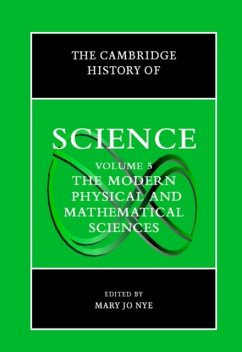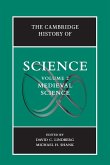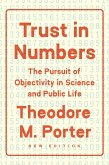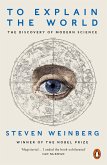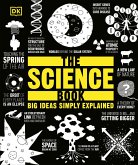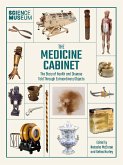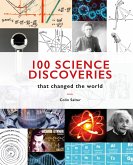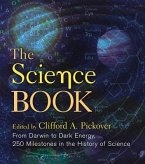Mary Jo Nye (ed.)
The Cambridge History of Science: Volume 5, the Modern Physical and Mathematical Sciences
Herausgeber: Nye, Mary Jo
Mary Jo Nye (ed.)
The Cambridge History of Science: Volume 5, the Modern Physical and Mathematical Sciences
Herausgeber: Nye, Mary Jo
- Gebundenes Buch
- Merkliste
- Auf die Merkliste
- Bewerten Bewerten
- Teilen
- Produkt teilen
- Produkterinnerung
- Produkterinnerung
A new and comprehensive examination by over thirty internationally recognized scholars of the history of the modern physical and mathematical sciences. The authors examine contested traditions and startling innovations within a broad range of scientific fields which are nonetheless connected.
Andere Kunden interessierten sich auch für
![The Cambridge History of Science The Cambridge History of Science]() David C. LindbergThe Cambridge History of Science49,99 €
David C. LindbergThe Cambridge History of Science49,99 €![Trust in Numbers Trust in Numbers]() Theodore M. PorterTrust in Numbers37,99 €
Theodore M. PorterTrust in Numbers37,99 €![To Explain the World To Explain the World]() Steven WeinbergTo Explain the World10,99 €
Steven WeinbergTo Explain the World10,99 €![The Science Book The Science Book]() DKThe Science Book18,99 €
DKThe Science Book18,99 €![Science Museum: The Medicine Cabinet Science Museum: The Medicine Cabinet]() Natasha McEnroeScience Museum: The Medicine Cabinet33,99 €
Natasha McEnroeScience Museum: The Medicine Cabinet33,99 €![100 Science Discoveries That Changed the World 100 Science Discoveries That Changed the World]() Colin Salter100 Science Discoveries That Changed the World23,99 €
Colin Salter100 Science Discoveries That Changed the World23,99 €![The Science Book The Science Book]() The Science Book33,99 €
The Science Book33,99 €-
-
-
A new and comprehensive examination by over thirty internationally recognized scholars of the history of the modern physical and mathematical sciences. The authors examine contested traditions and startling innovations within a broad range of scientific fields which are nonetheless connected.
Hinweis: Dieser Artikel kann nur an eine deutsche Lieferadresse ausgeliefert werden.
Hinweis: Dieser Artikel kann nur an eine deutsche Lieferadresse ausgeliefert werden.
Produktdetails
- Produktdetails
- The Cambridge History of Science
- Verlag: Cambridge University Press
- Seitenzahl: 708
- Erscheinungstermin: 28. Oktober 2002
- Englisch
- Abmessung: 234mm x 162mm x 50mm
- Gewicht: 1112g
- ISBN-13: 9780521571999
- ISBN-10: 0521571995
- Artikelnr.: 21228724
- Herstellerkennzeichnung
- Libri GmbH
- Europaallee 1
- 36244 Bad Hersfeld
- gpsr@libri.de
- The Cambridge History of Science
- Verlag: Cambridge University Press
- Seitenzahl: 708
- Erscheinungstermin: 28. Oktober 2002
- Englisch
- Abmessung: 234mm x 162mm x 50mm
- Gewicht: 1112g
- ISBN-13: 9780521571999
- ISBN-10: 0521571995
- Artikelnr.: 21228724
- Herstellerkennzeichnung
- Libri GmbH
- Europaallee 1
- 36244 Bad Hersfeld
- gpsr@libri.de
Introduction: the modern Physical and Mathematical Sciences Mary Jo Nye;
Part I. The Public Cultures of the Physical Sciences After 1800: 1.
Theories of scientific method: models for physico-mathematical sciences
Nancy Cartwright, Sthathis Psillos and Hasok Chang; 2. Intersections of
physical sciences and western religion in the nineteenth and twentieth
centuries Frederick Gregory; 3. A twisted tale: women in the physical
sciences in the nineteenth and twentieth centuries Margaret W. Rossiter; 4.
Scientists and their publics: popularization of science in the nineteenth
century David M. Knight; 5. Literature and the modern physical sciences
Pamela Gossin; Part II. Discipline-Building in the Sciences: Places,
Instruments, Communication: 6. Mathematical schools, communities, and
networks David E. Rowe; 7. The industry, research, education nexus Terry
Shinn; 8. Remaking astronomy: instruments and practice in the nineteenth
and twentieth centuries Robert W. Smith; 9. Languages in science: chemistry
Bernadette Bensaude-Vincent; 10. Imagery and representation in
twentieth-century physics from Einstein to Feynman Arthur I. Miller; Part
III. Chemistry and Physics: Problems through the Early 1900s: 11. The
physical sciences in the life sciences Frederic L. Holmes; 12. Chemical
atomism and chemical classifications Hans-Werner Schutt; 13. Theory and
applications of the structure theory in organic chemistry A. J. Rocke; 14.
Theories and experiments on radiation from Thomas Young to X-rays Sungook
Hong; 15. Force, energy, and thermodynamics Crosbie Smith; 16. Theories and
practices of electrical science from Faraday to Einstein Bruce J. Hunt;
Part IV. Atomic and Molecular Sciences in the Twentieth Century: 17.
Quantum theory and atomic structure, 1900-1927 Olivier Darrigol; 18.
Radioactivity and nuclear physics Jeff Hughes; 19. Quantum field theory:
from QED to the standard model S. S. Schweber; 20. Chemical physics and
quantum chemistry in the twentieth century Ana Simoes; 21. Plasmas and
solid-state science Michael Eckert; 22. Macromolecules, their structures
and functions Yasu Furukawa; Part V. Mathematics, Astronomy and Cosmology
since the Eighteenth Century: 23. The geometrical tradition: mathematics,
space and reason in the nineteenth century Joan L. Richards; 24. Between
rigor and application: developments in the concept of function in
mathematical analysis Jesper Lutzen; 25. Statistics and physical theories
Theodore M. Porter; 26. Solar science and astrophysics Joann Eisberg; 27.
Cosmologies and cosmogonies of space and time Helge Kragh; 28. The
chemistry and physics of the earth Naomi Oreskes and Ronald E. Doel; Part
VI. Problems and Promises at the End of the Twentieth Century: 29. Science,
technology, and war Alex Roland; 30. Science, ideology and the state:
physics in the twentieth century Paul Josephson; 31. Computer science and
the computer revolution William Aspray; 32. The physical sciences and the
physicians' eye: dissolving disciplinary boundaries Bettyann Holtzmann
Kevles; 33. Global environmental change and the history of science James
Rodger Fleming.
Part I. The Public Cultures of the Physical Sciences After 1800: 1.
Theories of scientific method: models for physico-mathematical sciences
Nancy Cartwright, Sthathis Psillos and Hasok Chang; 2. Intersections of
physical sciences and western religion in the nineteenth and twentieth
centuries Frederick Gregory; 3. A twisted tale: women in the physical
sciences in the nineteenth and twentieth centuries Margaret W. Rossiter; 4.
Scientists and their publics: popularization of science in the nineteenth
century David M. Knight; 5. Literature and the modern physical sciences
Pamela Gossin; Part II. Discipline-Building in the Sciences: Places,
Instruments, Communication: 6. Mathematical schools, communities, and
networks David E. Rowe; 7. The industry, research, education nexus Terry
Shinn; 8. Remaking astronomy: instruments and practice in the nineteenth
and twentieth centuries Robert W. Smith; 9. Languages in science: chemistry
Bernadette Bensaude-Vincent; 10. Imagery and representation in
twentieth-century physics from Einstein to Feynman Arthur I. Miller; Part
III. Chemistry and Physics: Problems through the Early 1900s: 11. The
physical sciences in the life sciences Frederic L. Holmes; 12. Chemical
atomism and chemical classifications Hans-Werner Schutt; 13. Theory and
applications of the structure theory in organic chemistry A. J. Rocke; 14.
Theories and experiments on radiation from Thomas Young to X-rays Sungook
Hong; 15. Force, energy, and thermodynamics Crosbie Smith; 16. Theories and
practices of electrical science from Faraday to Einstein Bruce J. Hunt;
Part IV. Atomic and Molecular Sciences in the Twentieth Century: 17.
Quantum theory and atomic structure, 1900-1927 Olivier Darrigol; 18.
Radioactivity and nuclear physics Jeff Hughes; 19. Quantum field theory:
from QED to the standard model S. S. Schweber; 20. Chemical physics and
quantum chemistry in the twentieth century Ana Simoes; 21. Plasmas and
solid-state science Michael Eckert; 22. Macromolecules, their structures
and functions Yasu Furukawa; Part V. Mathematics, Astronomy and Cosmology
since the Eighteenth Century: 23. The geometrical tradition: mathematics,
space and reason in the nineteenth century Joan L. Richards; 24. Between
rigor and application: developments in the concept of function in
mathematical analysis Jesper Lutzen; 25. Statistics and physical theories
Theodore M. Porter; 26. Solar science and astrophysics Joann Eisberg; 27.
Cosmologies and cosmogonies of space and time Helge Kragh; 28. The
chemistry and physics of the earth Naomi Oreskes and Ronald E. Doel; Part
VI. Problems and Promises at the End of the Twentieth Century: 29. Science,
technology, and war Alex Roland; 30. Science, ideology and the state:
physics in the twentieth century Paul Josephson; 31. Computer science and
the computer revolution William Aspray; 32. The physical sciences and the
physicians' eye: dissolving disciplinary boundaries Bettyann Holtzmann
Kevles; 33. Global environmental change and the history of science James
Rodger Fleming.
Introduction: the modern Physical and Mathematical Sciences Mary Jo Nye;
Part I. The Public Cultures of the Physical Sciences After 1800: 1.
Theories of scientific method: models for physico-mathematical sciences
Nancy Cartwright, Sthathis Psillos and Hasok Chang; 2. Intersections of
physical sciences and western religion in the nineteenth and twentieth
centuries Frederick Gregory; 3. A twisted tale: women in the physical
sciences in the nineteenth and twentieth centuries Margaret W. Rossiter; 4.
Scientists and their publics: popularization of science in the nineteenth
century David M. Knight; 5. Literature and the modern physical sciences
Pamela Gossin; Part II. Discipline-Building in the Sciences: Places,
Instruments, Communication: 6. Mathematical schools, communities, and
networks David E. Rowe; 7. The industry, research, education nexus Terry
Shinn; 8. Remaking astronomy: instruments and practice in the nineteenth
and twentieth centuries Robert W. Smith; 9. Languages in science: chemistry
Bernadette Bensaude-Vincent; 10. Imagery and representation in
twentieth-century physics from Einstein to Feynman Arthur I. Miller; Part
III. Chemistry and Physics: Problems through the Early 1900s: 11. The
physical sciences in the life sciences Frederic L. Holmes; 12. Chemical
atomism and chemical classifications Hans-Werner Schutt; 13. Theory and
applications of the structure theory in organic chemistry A. J. Rocke; 14.
Theories and experiments on radiation from Thomas Young to X-rays Sungook
Hong; 15. Force, energy, and thermodynamics Crosbie Smith; 16. Theories and
practices of electrical science from Faraday to Einstein Bruce J. Hunt;
Part IV. Atomic and Molecular Sciences in the Twentieth Century: 17.
Quantum theory and atomic structure, 1900-1927 Olivier Darrigol; 18.
Radioactivity and nuclear physics Jeff Hughes; 19. Quantum field theory:
from QED to the standard model S. S. Schweber; 20. Chemical physics and
quantum chemistry in the twentieth century Ana Simoes; 21. Plasmas and
solid-state science Michael Eckert; 22. Macromolecules, their structures
and functions Yasu Furukawa; Part V. Mathematics, Astronomy and Cosmology
since the Eighteenth Century: 23. The geometrical tradition: mathematics,
space and reason in the nineteenth century Joan L. Richards; 24. Between
rigor and application: developments in the concept of function in
mathematical analysis Jesper Lutzen; 25. Statistics and physical theories
Theodore M. Porter; 26. Solar science and astrophysics Joann Eisberg; 27.
Cosmologies and cosmogonies of space and time Helge Kragh; 28. The
chemistry and physics of the earth Naomi Oreskes and Ronald E. Doel; Part
VI. Problems and Promises at the End of the Twentieth Century: 29. Science,
technology, and war Alex Roland; 30. Science, ideology and the state:
physics in the twentieth century Paul Josephson; 31. Computer science and
the computer revolution William Aspray; 32. The physical sciences and the
physicians' eye: dissolving disciplinary boundaries Bettyann Holtzmann
Kevles; 33. Global environmental change and the history of science James
Rodger Fleming.
Part I. The Public Cultures of the Physical Sciences After 1800: 1.
Theories of scientific method: models for physico-mathematical sciences
Nancy Cartwright, Sthathis Psillos and Hasok Chang; 2. Intersections of
physical sciences and western religion in the nineteenth and twentieth
centuries Frederick Gregory; 3. A twisted tale: women in the physical
sciences in the nineteenth and twentieth centuries Margaret W. Rossiter; 4.
Scientists and their publics: popularization of science in the nineteenth
century David M. Knight; 5. Literature and the modern physical sciences
Pamela Gossin; Part II. Discipline-Building in the Sciences: Places,
Instruments, Communication: 6. Mathematical schools, communities, and
networks David E. Rowe; 7. The industry, research, education nexus Terry
Shinn; 8. Remaking astronomy: instruments and practice in the nineteenth
and twentieth centuries Robert W. Smith; 9. Languages in science: chemistry
Bernadette Bensaude-Vincent; 10. Imagery and representation in
twentieth-century physics from Einstein to Feynman Arthur I. Miller; Part
III. Chemistry and Physics: Problems through the Early 1900s: 11. The
physical sciences in the life sciences Frederic L. Holmes; 12. Chemical
atomism and chemical classifications Hans-Werner Schutt; 13. Theory and
applications of the structure theory in organic chemistry A. J. Rocke; 14.
Theories and experiments on radiation from Thomas Young to X-rays Sungook
Hong; 15. Force, energy, and thermodynamics Crosbie Smith; 16. Theories and
practices of electrical science from Faraday to Einstein Bruce J. Hunt;
Part IV. Atomic and Molecular Sciences in the Twentieth Century: 17.
Quantum theory and atomic structure, 1900-1927 Olivier Darrigol; 18.
Radioactivity and nuclear physics Jeff Hughes; 19. Quantum field theory:
from QED to the standard model S. S. Schweber; 20. Chemical physics and
quantum chemistry in the twentieth century Ana Simoes; 21. Plasmas and
solid-state science Michael Eckert; 22. Macromolecules, their structures
and functions Yasu Furukawa; Part V. Mathematics, Astronomy and Cosmology
since the Eighteenth Century: 23. The geometrical tradition: mathematics,
space and reason in the nineteenth century Joan L. Richards; 24. Between
rigor and application: developments in the concept of function in
mathematical analysis Jesper Lutzen; 25. Statistics and physical theories
Theodore M. Porter; 26. Solar science and astrophysics Joann Eisberg; 27.
Cosmologies and cosmogonies of space and time Helge Kragh; 28. The
chemistry and physics of the earth Naomi Oreskes and Ronald E. Doel; Part
VI. Problems and Promises at the End of the Twentieth Century: 29. Science,
technology, and war Alex Roland; 30. Science, ideology and the state:
physics in the twentieth century Paul Josephson; 31. Computer science and
the computer revolution William Aspray; 32. The physical sciences and the
physicians' eye: dissolving disciplinary boundaries Bettyann Holtzmann
Kevles; 33. Global environmental change and the history of science James
Rodger Fleming.

